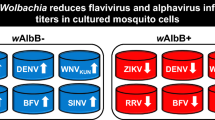Summary
The replication of Marituba virus (Bunyavirus genus, family Bunyaviridae), was studied inAedes albopictus (mosquito) cells. Infection ofAedes albopictus cells with Marituba virus was characterized by an initial acute phase of infection in which large amounts of virus were produced and further by a persistent phase of infection in which virus yield was much lower. No changes in host cell DNA, RNA and protein synthesis were observed inAedes albopictus cells infected with Marituba virus. In contrast in L-A9 (mouse fibroblasts) cells this virus shut-off the host macromolecular synthesis. During the replication of MTB virus in L-A9 cells three virus-specific proteins (G1, G2 and N) were detected. InAedes albopictus cells, Marituba virus replicates slowly and two virus-specific proteins (G1 and N) accumulate in these cells.
Similar content being viewed by others
References
Berge, T. O.: International Catalogue of Arboviruses, 2nd. ed. Center for Disease Control, Atlanta, Georgia. U.S. Department of Health, Education and Welfare. Publication 75-8301 (1975).
Bishop, D. H. L., Shope, R. E.: Bunyaviridae. In:Fraenkel-Conrat, Wagner (eds.): Comprehensive Virology, Vol.14, 1–56. New York: Plenum 1979.
Bouloy, M., Vialat, P., Girard, M., Pardigon, N.: A transcript from the 5' segment of the Germiston Bunyavirus is uncapped and codes for the nucleoprotein and a nonstructural protein. J. Virol.49, 717–723 (1984).
Causey, O. R., Causey, C. E., Maroja, O. M., Macedo, D. G.: The isolation of arthropod-borne viruses, including members of two hitherto undescribed serological groups, in the Amazon region of Brazil. Amer. J. Trop. Med. Hyg.10, 227–249 (1961).
de Paola, D., Bruno-Lobo, M., Duarte, F.: Histopatologia experimental dos arbovírus dos grupos C e Guama. An. Microbiol.11, 133–160 (1963).
Fenner, F.: Classification and nomenclature of viruses. Second report of the International Commitee on Taxonomy of Viruses. Intervirology7, 1–116 (1976).
Fuller, F., Bishop, D. H.: Identification of virus-coded nonstructural polypeptides in Bunyavirus-infected cells. J. Virol.41, 643–648 (1982).
Frugulhetti, I. C., Soares, M. C. M., Rebello, M. A.: Structural Proteins of Marituba virus (Bunyaviridae). Intervirology20, 143–148 (1983).
Huang, A. S., Baltimore, D.: Detective interfering animal viruses. In:Fraenkel-Conrat, Wagner (eds.): Comprehensive Virology Vol.10, 75–106. New York: Plenum 1977.
Igarashi, A.: Isolation of a Singh'sAedes albopictus cell clone sensitive to Dengue and Chikungunya viruses. J. gen. Virol.40, 531–544 (1978).
Kascsak, R. J., Lyons, M. J.: Bunyamwera virus. II. The generation and nature of defective interfering particles. Virology89, 539–546 (1978).
Laemmli, U. K.: Cleavage of structural proteins during the assembly of the head of bacteriophage T4. Nature, Lond.227, 680–685 (1970).
Lazdins, I., Holmes, I. H.: Protein synthesis in Bunyamwera virus-infected cells. J. gen. Virol.44, 121–133 (1979).
Obijeski, J. F., Bishop, D. H. L., Murphy, F. A., Palmer, E. L.: Structural proteins of La Crosse virus. J. Virol.19, 985–997 (1976).
Pettersson, R. F.: Effect of Uukuniemi virus infection on host cell macromolecule synthesis. Med. Biol.52, 90–97 (1974).
Rebello, M. A., Volkmer, N., Frugulhetti, I. C., Soares, M. C. M.: Macromolecular synthesis in L-A 9 cells infected with Marituba virus. Arch. Virol.68, 327–332 (1981).
Riedel, B., Brown, D.: Role of Extracellular virus in the maintenance of the persistent infection induced inAedes albopictus (Mosquito) cells by Sindbis Virus. J. Virol.23, 554–561 (1977).
Ulmanen, I., Seppala, P., Petterson, R. F.:In vitro translation of Uukuniemi virus-specific RNAs: identification of a nonstructural protein and a precursor to the membrane glycoproteins. J. Virol.37, 72–79 (1981).
Ushijima, H., Clerx van Haaster, C. M., Bishop, D. H. L.: Analyses of Patois group bunyaviruses; evidence for naturally occurring recombinant bunyaviruses and existence of viral coded nonstructural proteins induced in bunyavirus infected cells. Virology110, 312–318 (1981).
Volkmer, N., Rebello, M. A.: A plaque assay method for Marituba virus in mouse L-A 9 cells. IRCS Med. Sci.9, 157–158 (1981).
Volkmer, N., Soares, M. C. M., Rebello, M. A.: Autointerference of Marituba virus (Bunyaviridae) in mouse L cells by defective interfering particles. Intervirology20, 108–113 (1983).
Author information
Authors and Affiliations
Additional information
With 4 Figures
Rights and permissions
About this article
Cite this article
Carvalho, M.G.C., Frugulhetti, I.C. & Rebello, M.A. Marituba (Bunyaviridae) virus replication in culturedAedes albopictus cells and in L-A9 cells. Archives of Virology 90, 325–335 (1986). https://doi.org/10.1007/BF01317380
Received:
Accepted:
Issue Date:
DOI: https://doi.org/10.1007/BF01317380




